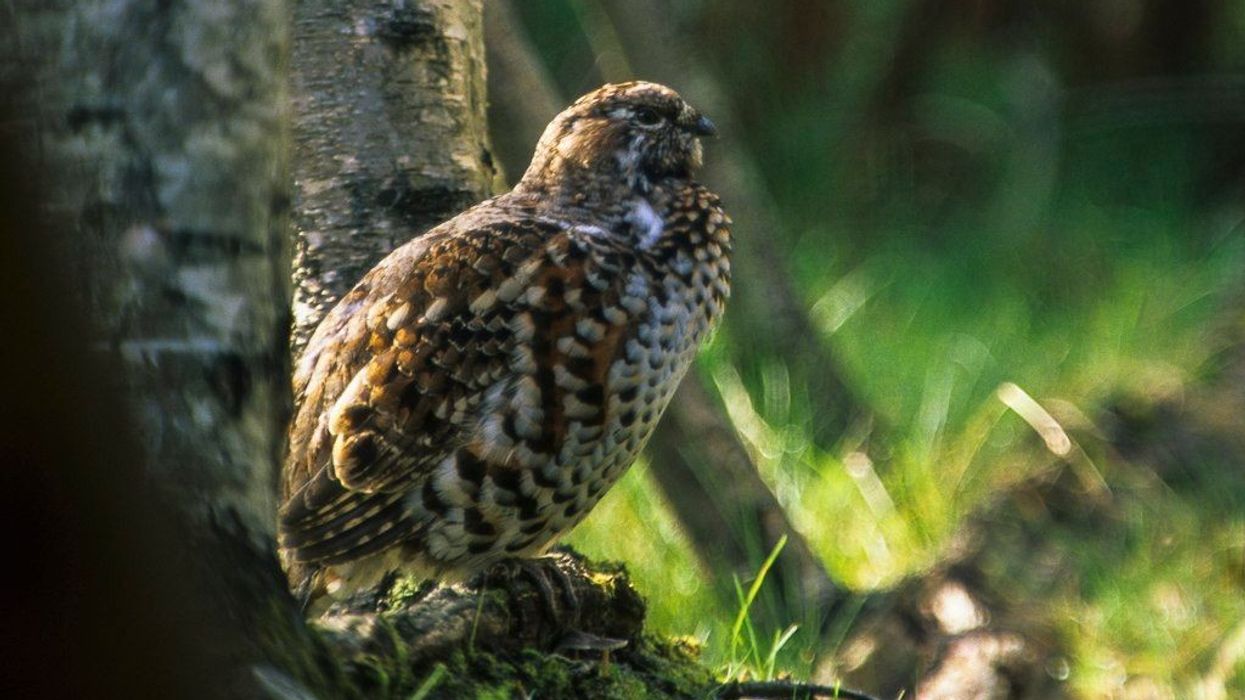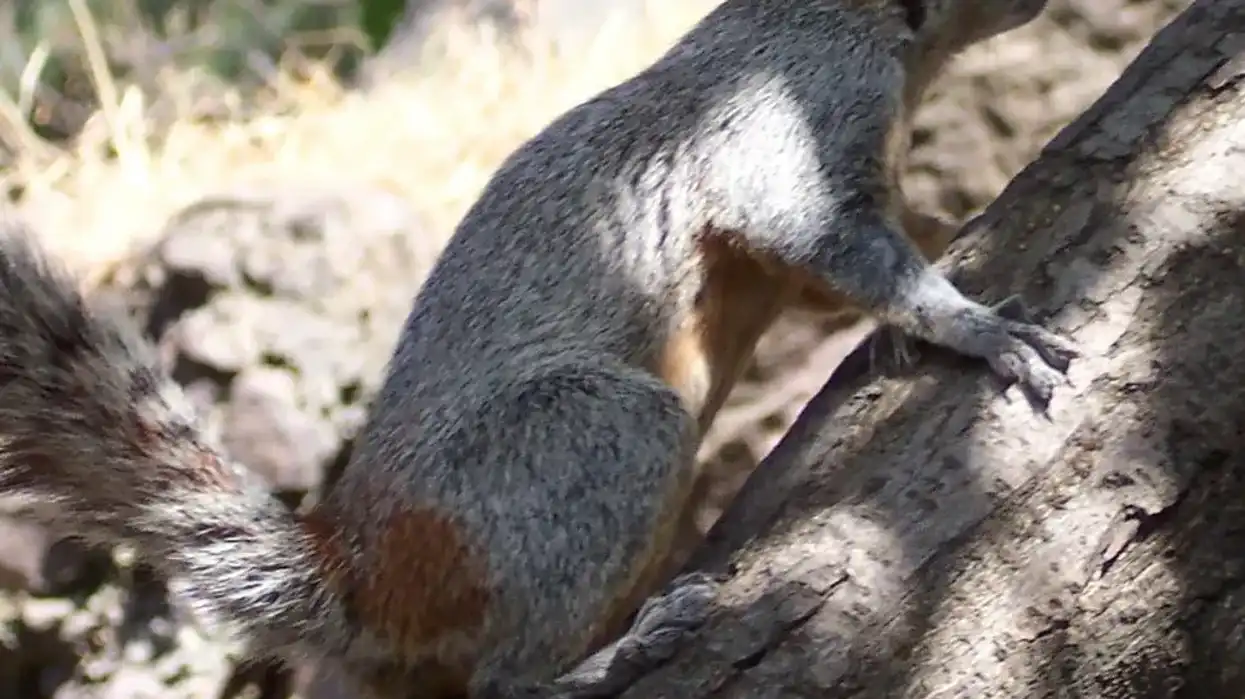The eastern grey squirrel or grey squirrel, Sciurus carolinensis, is an arboreal rodent. It is a species that is native to North America and is an important component of the forest ecology.
Grey squirrels were located and introduced to Europe and are considered an invasive animal species in some regions. Grey squirrels are recognized by their grey fur but can also have brown fur.
It has a white underside and a bushy tail. In certain urban locations, a complete black species can be found too. Grey squirrels melanistic species can tolerate colder climates than the regular grey ones.
The eastern grey squirrel is known as a scatter-hoarder. Meaning it will hoard food at numerous locations in small caches to recover later.
They are estimated to make several thousand caches individually in every season. Some are temporary caches from where it will collect the food to transfer to a more permanent cache place.
From the permanent spot, the food is not retrieved until required. The invasive grey squirrel or eastern grey squirrel has excellent spatial memory to track the location of each cache while using distant and nearby landmarks to do so. Grey squirrels use their sense of smell to receive the food cache.
Eastern grey squirrel adaptations can descend from a tree headfirst. After reading these interesting grey squirrel facts, do check our other articles on weasel facts and roof rat facts as well.
Grey Squirrel Interesting Facts
What type of animal is a grey squirrel?
Grey squirrels, Sciurus carolinensis, are a type of rodent who mostly live on trees. Grey squirrels are native to North America but are found in Europe and Africa too. They are an important species as natural forest regenerators.
What class of animal does a grey squirrel belong to?
Grey squirrels belong to the class of mammals, as they give birth to offspring like other mammals.
How many grey squirrels are there in the world?
The exact number of grey squirrels in the world is difficult to find as they are found in varied regions. The eastern grey squirrels have adapted well to urban regions too. In certain regions in Europe, eastern grey squirrels are considered an invasive species.
Where does a grey squirrel live?
The grey squirrel or eastern grey squirrel is found in the eastern region of the United States from west of the Mississippi River in the south to Canada in the north. The eastern grey squirrel has been introduced to many western states, England, Scotland, and Ireland.
Female eastern red squirrels are also introduced in western Canada, southwest British Columbia.
In the United States, they are introduced in Oregon, Washington, and California. Later they were introduced in South Africa, Hawaii, Bermuda, Madeira island, the Canary Islands, the Azores, Italy, and Cape Verde.
What is a grey squirrel's habitat?
The grey squirrel habitat prefers mature continuous wildlife woodlands with diverse wildlife vegetation to meet their diet. They prefer wildlife regions with food that is available through the late winter. In the urban landscape and wildlife in the late winter, they are found in parks, back yards, farmlands, and some rural settlements too.
Who do grey squirrels live with?
Grey squirrels are mostly solitary creatures in wildlife, but they can be observed communicating with other squirrels or warning them about predators in wildlife. They may acknowledge each other as being wildlife animals among leaves and twigs.
How long does a grey squirrel live?
The grey squirrel's lifespan is 12.5-20 years. In the wild, they may live for 12.5 years or less, but in captivity, they may live for up to 20 years.
How do they reproduce?
Female squirrels are common and may mate with more than one male in the wild during the breeding season. Males are known to compete with other males to mate and breed twice. Common tail males in the wild will start following females five days before estrus.
The female’s estrus is observed with an enlarged pink vulva which will last for eight hours. The vagina is normally closed in pubescent or older females. Copulation lasts for less than 30 seconds.
Once ejaculation is done, a gelatinous white plug is formed, which doesn't let more sperm enter. These periods are during December to February and May to June. The gestation period is 44 days.
Newborns are naked at birth and are altricial. They are born pink with no hair. Although vibrissae are present, after seven to eight days, the skin will darken.
The younger female will have one litter per year until she gains experience to reproduce twice. Also, the availability of food can decide for one or two litters a year. The litter size is normally 1-4 kits.
What is their conservation status?
The conservation status of the grey squirrel is of Least Concern as the population is stable and increasing. In certain areas where the species was introduced, the population is said to be invasive.
Although habitat loss and human encroachment may be a cause for concern for them, the species has adapted well to co-exist with humans in urban and rural areas.
Grey Squirrel Fun Facts
What do grey squirrels look like?
Grey squirrels are medium-sized tree squirrels. The male and the female are similar looking with very few differentiating factors. They come in grey to browning tones of fur. Their ears are pale grey or white like their short bushy tails.
The underside is white or pale grey. An adult has 22 teeth. In certain urban locations, a complete black species can be found too.
How do they communicate?
Grey squirrels will communicate with each other with different kinds of vocal sounds. They are known to communicate with different postures, too, like flicking their tails. They use their sense of smell, too, while determining the level of stress or reproductive conditions. Grey squirrels also use body movements like tail flicking to communicate their thoughts.
How big is a grey squirrel?
Grey squirrels are medium-sized tree squirrels. They grow to a size of 9-12 in (22.86-30.48 cm), including the tail.
How fast can a grey squirrel run?
Grey squirrels can run at a speed of around 20 mph (32.18 kph). These squirrels are known as quick animals who can climb up and down trees, too. The eastern grey squirrel can descend from a tree headfirst. They do this by turning their feet so that the hind paws are backwards-pointing and can grip the tree bark.
How much does a grey squirrel weigh?
The grey squirrel weighs between 0.88-1.32 lb (0.39-0.59 kg).
What are the male and female names of the species?
The male grey squirrel is called a buck, and the female is called a doe. Their group name is called a colony, dray, or scurry.
What would you call a baby grey squirrel?
The baby squirrel is called kit, pup, or kitten.
What do they eat?
The grey squirrel diet consists of a variety of items ranging from nuts and seeds to small frogs or nestlings and eggs. It mostly eats flowers, nuts, buds of more than 24 species of oaks, 10 species of hickory, walnut, pecan, and beech tree.
They eat seeds, nuts, flowers, buds, or fruits of mulberry, maple, elm, hackberry, horse chestnut fruit, and bucky. Also, they eat dogwood, wild cherry, black gum, hawthorn, hop hornbeam, hazelnut, and ginkgo trees’ seed, nuts, bud, flower, and fruits.
The catkins and seeds of hemlock, cedar, spruce and pine along with varied fungi and herbaceous plants are a part of their diet. They will eat crops like corn and wheat. The juveniles may eat insects.
They may also eat bird eggs, nestlings, bones, and frogs. They are known as scatter hoarders, who build caches of food at thousands of places.
Are they dangerous?
Squirrels are not dangerous or harmful to humans. They are adaptive creatures who have learned to survive in urban and rural landscapes. They are not aggressive towards humans and may bite only when disturbed.
Would they make a good pet?
The grey squirrel baby is not known to interact with humans a lot as they are wary of us like many creatures. But they are found to co-exist with humans.
Did you know...
Female grey squirrels are more active during summers, and males are more active during winters. During the summer, spring, and fall months, they are active during dusk and dawn. Their home ranges are larger during the summer months.
They prefer oak-hickory hardwood forests over coniferous forests as food foraging is easier in hardwood forests. They construct their dens on large tree branches or inside a hollow tree.
They will use an abandoned nest of a bird. They will line their dens with thistledown, moss plants, feathers, and dried grass. They can bury food beneath a foot of snow.
These squirrels will zigzag their ways to escape predators. Grey squirrels are known to pretend to bury food items when they sense someone is watching them.
Grey squirrels are known to leap 10 times their body length. They use their tails for balancing and as a parachute while jumping or falling. These squirrels can learn to navigate through various obstacles and find the most efficient route towards their food caches due to their spatial memory. They are good at finding shortcuts too.
Grey squirrel vs red squirrel
Red squirrels are relatively smaller than grey squirrels. The red ones are more aggressive, whereas the grey ones are known to be docile or shy.
Both are known to be busy creatures who do not hibernate or stop and rest during the winters. Grey squirrels are said to be smarter and more intelligent than red ones. Grey squirrels can be known to kill red ones through the parapoxvirus.
What adaptations do grey squirrel have?
In order to survive and dwell in their environment, they have adapted to eat a variety of food and animals too. In certain urban locations, a complete black species can be found too. These melanistic species can tolerate colder climates than regular grey ones.
Here at Kidadl, we have carefully created lots of interesting family-friendly animal facts for everyone to discover! For more relatable content, check out these red squirrel facts, and brown rat facts.
You can even occupy yourself at home by drawing one on our grey squirrel coloring pages.










